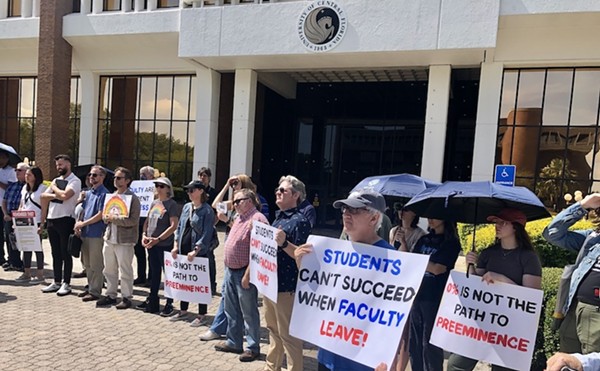There it sits, bottom shelf, aisle four at the Colonialtown Publix. One little packet of sustenance – wheat flour, thiamine mononitrate, canola oil, cottonseed oil, hydrolyzed soy, corn and wheat protein, monosodium glutamate and a laundry list of other stuff you really shouldn’t eat – neatly wrapped in red plastic and priced at 20 cents, its 380 calories (120 from fat) all adding up to the universal symbol for just getting by: Top Ramen.
There are 320,000 people currently living on food stamps in Central Florida, many of whom are probably familiar with Nissin’s three-minute “oodles of noodles” concoction. Statewide, more than 1 million people benefit from the federal food stamp plan; 28 million in the country. On average, most beneficiaries survive on $85 a month for groceries, even when the United States Department of Agriculture, which oversees the food stamp program, estimates that a family of four on a “moderate cost” shopping plan averages $900 a month at their local market.
A recent University of Washington study put grocery prices to the test. Among the 370 foods sampled, they found that energy-dense junk food cost an average of $1.76 per 1,000 calories, while nutritious, unprocessed foods came in at a whopping $18.16 per 1,000 calories. The disparity helps explain the myth that the nation’s obese poor are fat because they choose to be. In reality, there isn’t much choice at all.
“It’s not a hard thing to imagine when you’re in a grocery store and you’re looking at a red bell pepper that costs four bucks,” says Greg Higgerson, development director for Central Florida Second Harvest Food Bank, “while two aisles over you’ve got a shrink-wrapped value pack of six boxes of macaroni and cheese for four bucks. That’ll last, that’ll fill your kid’s belly.”
The real culprit may be the USDA itself. The 2007 version of the Farm Bill – America’s all-encompassing food-spending proposal that includes farm subsidies, conservation and nutrition titles – failed to pass muster last year. It’s those agribusiness subsidies that perpetuate the distribution of processed foods like high-fructose corn syrup and partially hydrogenated oils. This year, the mammoth $288 billion legislation is in danger of a veto by President George Bush if it fails to trim subsidies or raises taxes.
Meanwhile, local agencies that distribute aid to the hungry are being stretched to their limits, trying to reconcile an unhealthy system with a failing economy and rising food prices. And the poor keep getting fatter.
But at least they’re eating, right?
It wasn’t always this way. For the better part of 80 years, the USDA farm bill has served as a relief valve on the nation’s food supply. If crop prices fell below a certain level, taxpayer money kicked in to prevent economic collapse for the farmers. But the recent increases in prices for commodity crops – corn, wheat, rice, cotton, soybeans – has turned the focus on the inner workings of the system.
According to Michelle Perez, senior agricultural analyst for Washington, D.C.-based Environmental Working Group, the system is broken. Farms are now being subsidized with $5 billion in automatic, fixed direct payments, meaning that landowners who used to grow corn, but don’t anymore, are still receiving sizable checks. Moreover, in the case of corn, 60 to 70 percent of domestic production goes to feeding livestock, 10 percent goes to food additives like high-fructose corn syrup, and most of the remainder is tied up in ethanol production. The federally mandated ethanol shift has resulted in farmers clearing more land for the commodity crop. This year, corn prices have shot up 30 percent to an all-time high of $6 per bushel, and are expected to jump even higher.
“It’s been a long time coming, but maybe this is the year that policy makers realize how foolish it was to use food crops to create gasoline,” Perez says. “Now we also know that not only when you take away a food crop, the food manufacturers and the livestock producers suffer. Now we know that putting that into the gasoline mix not only does not help global warming, which was the original intention, it actually accelerates global warming because of land conversion.”
And even though 70 percent of the $288 billion, five-year bill is earmarked for nutrition – predominantly for the 28 million people living on food stamps – that’s hard to reconcile with the fact that in 2007, the president’s own panel on cancer found that the government is not doing its job in keeping up with the country’s nutritional needs. Their report suggests that commodity crops themselves may be leading to unhealthy eating habits.
“Current agricultural and public health policy is not coordinated – we heavily subsidize the growth of foods (e.g., corn, soy) that in their processed forms (e.g., high fructose corn syrup, hydrogenated corn and soybean oils, grain-fed cattle) are known contributors to obesity and associated chronic diseases, including cancer,” the panel’s report concluded.
Best-selling food author Michael Pollan wrote an op-ed in the Nov. 4 New York Times calling foul on the USDA and its “entire hoary contraption of direct payments, countercyclical payments and loan deficiency payments that subsidize the five big commodity crops – corn, wheat, rice, soybeans and cotton – to the tune of $42 billion over five years.”
A subsequent Times piece on April 2, “Some Good News on Food Prices,” highlighted “food intellectual” Pollan’s crusade, taking it a step further to suggest that the increase in commodity food prices may outpace that of healthier foods, leaving consumers with the viable option of nutritious meals at the same cost.
But not all food pragmatists are biting. Jim Weill, president of the Food Research and Action Center, delivered a speech April 16 to the House Hunger Caucus rebutting that “good news.” He countered that fruits and vegetables have tripled in price since the 1980s, while food in general has only doubled.
“Fully 25 percent of American households with children are food insecure or only marginally food secure,” he said. (Food insecurity means that members of the family are skipping meals or cutting portions to get by.) “There is great harm to the nation’s future when it is becoming far harder for these and other struggling households to purchase enough food, much less healthy foods. This is not a positive social change. For those reasons, the article would be wrong even if healthy foods were readily available to low-income people, and at reasonable prices, but often they are not.”
***
About two-thirds of Americans are overweight or obese, according to the Journal of the American Medical Association. A 2005 study by the Florida Department of Health found that 60.7 percent of adult residents were overweight or obese in Florida, with 22.8 percent registering as clinically obese. Only 26.2 percent of Florida adults reported eating the recommended five servings of fruits and vegetables daily.
“At some point we have to realize that if we really want to address obesity, and we want children from low incomes to really have access to higher-quality foods, we’re going to have to fund the programs that feed them at a level that allows this,” says Debra Susie, executive director of Florida Impact, a Tallahassee group dedicated to addressing Florida’s hunger issues since 1979.
Florida Impact has worked with the Food Research and Action Center – a Washington, D.C., nonprofit fighting hunger nationally – to find ways to further the cause of ending hunger statewide, namely by improving the systems already in place.
“A food stamp recipient receives only 78 cents per meal on average,” she says. “Who of us could really buy a meal for that amount of money?”
Susie adds, “If you don’t have enough money to buy the amount of food you need, you rely on cheaper, high-caloric foods to cope and stave off hunger, and that’s where you get into the obesity thing.”
She says that unless something is done soon, the low-income kids who are becoming obese today are going to become burdens on the medical system, likely battling Type 2 diabetes.
The Florida Department of Children and Families is doing its part to make its services more accessible through its Automated Community Connection to Economic Self-Sufficiency program. Zella Reid, community partnership specialist for DCF’s Ninth Circuit, covering Orange and Osceola counties, points to their recent restructuring, which took the onus off the overcrowded call centers and spread it out to 450 community partners and the Internet.
“Most of the folks in our area are working two or three jobs, so there isn’t time to go,” she says. “But when the application is available `online`, that means it’s 24/7.”
In order to qualify for food stamps – which are distributed on electronic balance transfer cards – applicants must earn a gross income below 130 percent of the federal poverty level (or less than $1,107 per month for a single-person household), and can only have up to $2,000 in assets. According to Reid, her circuit saw a 20 percent increase in applicants between the months of January and February, and hands out an average of $9 million a month.
She says that with the increases comes a stronger focus on nutrition.
“A lot of our community partners, I think, are trying to expand their services, and not just offer `the` ACCESS `program` but the kind of things that can help you stretch your food dollar and keep your kids healthy. And that in turns helps keep you out of the emergency rooms. So it’s all interrelated.”
The Orange County Health Department, which manages the federal government’s complementary Women, Infants and Children program, is facing an onslaught too. With more lenient guidelines – WIC requires an income below 185 percent of the federal poverty guidelines – they report $1.7 million in food check vouchers redeemed per month.
WIC offers individual nutrition assessments and counseling by trained nutritionists. Orange County WIC coordinator Debbie Amoedo says that although the program currently encourages healthy eating by limiting food check redemptions to milk, cheese, eggs, fruit juice, dried beans, peanut butter and fortified cereals, more substantial nutritional improvements are on the immediate horizon.
“We do provide 100 percent fruit juice,” she says. “But very soon, in the next year at the federal level, there will be some changes to the types of foods being provided and fruits and vegetables will be provided. It’s something that’s been a long time coming.”
With his agency set to deliver 18 million pounds of food this year in the Central Florida region, Second Harvest’s Higgerson is cautious about too much food intellectualization. Hunger is the real issue.
“As much as anything else, hunger in America, unlike the rest of the world – where the problem of hunger is really more about food supply, about what’s available to them – that’s not the problem in America,” he says. “It’s much more of a problem of economics. We have enough food for everybody here. The trick is, you have to be able to buy it. Enough people are not able to do that regularly that we need sort of a safety net out there.”
That safety net, he says, largely relies on the first line of defense: food stamps. While a Bush veto looms as special interests hash out the complexities of the farm bill, Higgerson maintains that the bill itself is essential.
“I can tell you the nutrition title part of that bill is just such a huge piece. If that goes away, there will be noticeable differences on the streets of this community, in ways that people aren’t expecting,” he says. “When that safety net gets yanked, there’s going to be all kinds of problems.”
[email protected]
















